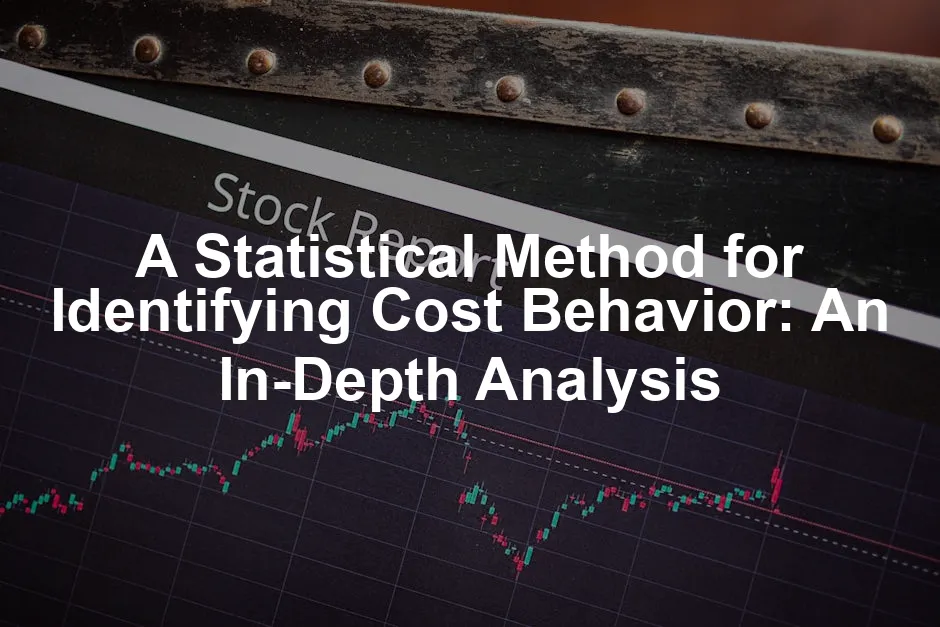How to Use:
- Gather historical data on costs and corresponding activity levels.
- Plot the data points on a graph, with costs on the vertical axis and activity levels on the horizontal axis.
- Analyze the pattern. If the points form a straight line, you have a linear relationship; if they scatter, costs might behave differently.
Benefits and Limitations: Scatter diagrams give immediate visual insights into cost behavior. They’re great for spotting trends! However, they can be tricky if outliers sneak in. These pesky data points can skew your results, leading to misunderstandings about your costs. Think of them as the party crashers of data—fun but potentially disruptive!

High-Low Method
Definition: The high-low method is a straightforward approach that uses the highest and lowest activity levels to determine variable costs. It’s like playing hide-and-seek with your costs, except you’re always seeking the extremes!
Calculation Process:
- Identify the highest and lowest activity levels and their corresponding costs.
- Calculate the variable cost per unit: Variable Cost = (Cost at High Activity – Cost at Low Activity) / (High Activity Level – Low Activity Level)
- Determine fixed costs by subtracting variable costs from total costs at either the high or low activity level.
Advantages and Disadvantages: The high-low method allows for quick estimations, making it a favorite among busy managers. However, it relies on just two data points. If those points are not representative, your analysis might miss the mark. It’s like trying to guess the weather based on a single sunny day—sometimes, you just need more data!

By leveraging both scatter diagrams and the high-low method, businesses can gain a clearer picture of their cost behavior. These statistical methods serve as essential tools for effective financial management, helping businesses navigate through the twists and turns of cost fluctuations. For those looking to enhance their financial modeling skills, Financial Modeling for Business Owners and Entrepreneurs can be invaluable.
Least-Squares Regression Method
Definition: This method minimizes the sum of the squares of the residuals. Residuals are the differences between observed and predicted values. Think of it as trying to find the perfect fit for your favorite pair of jeans—nobody wants those awkward gaps!
How it Works: The regression equation is a linear formula: Y = a + bX Here, Y represents the total cost, X is the activity level, a is the fixed cost, and b is the variable cost per unit. The goal? Find the best line that predicts costs based on your activity levels.
Benefits: The least-squares regression method offers accurate predictions. By using all available data points, it smooths out the noise. This means you get a clearer picture of how costs behave. It’s like having a crystal ball that actually works!
Limitations: However, be cautious. This method can be complex for beginners. Plus, if the model fits your data too closely, you might end up with overfitting. That’s when your model is too tailored to past data and struggles with new scenarios—like wearing winter clothes in July!

Composite and CVP Charting Methods
Composite Method: This technique combines multiple data points for a broader perspective. By aggregating information, it helps you see the bigger picture. Imagine trying to solve a jigsaw puzzle—each piece contributes to the final image.
CVP (Cost-Volume-Profit) Charting: This method focuses on the relationship between costs, volume, and profits. It’s like a tightrope walk—understanding how changes in costs or volume impact profitability is crucial for maintaining balance. Using CVP analysis, businesses can visualize critical points, such as breakeven levels. This insight aids in strategic decision-making by clarifying how much product must be sold to cover costs.
In summary, both composite and CVP charting methods are essential tools for analyzing cost behavior. They provide clarity and aid in financial planning, equipping businesses with the knowledge needed to thrive in a competitive landscape. If you’re interested in further reading on business analysis techniques, check out Business Analysis Techniques: 99 Essential Tools for Success.

Challenges in Identifying Cost Behavior
Identifying cost behavior isn’t all sunshine and rainbows. Companies often face hiccups along the way. Understanding these challenges can help you dodge those pesky pitfalls.
Common Pitfalls
One of the most common issues is misclassification of costs. It’s like labeling a cat as a dog. If you mistake fixed costs for variable ones, your forecasts will be as reliable as a weather forecast in a rainstorm. This misstep can lead to poor budgeting decisions and unexpected financial surprises. To help avoid this, consider picking up Cost Accounting: A Managerial Emphasis.
Another significant pitfall is an over-reliance on historical data. While past performance can provide valuable insights, it’s not always the best crystal ball for the future. Just because your costs behaved a certain way last year doesn’t mean they will this year. Think of it like trying to predict the outcome of a sequel based on the original movie. The plot can take unexpected turns!

Strategies to Overcome Challenges
So, how do you steer clear of these traps? Using multiple methods for validation is a great start. By employing different statistical techniques, you can cross-check results. It’s like using a GPS and a paper map. When both point to the same destination, you can feel confident you’re on the right track.
Regularly updating your cost behavior analysis is also crucial. Businesses evolve, and so do their cost structures. Reflect changes in operations, product lines, or market conditions. Keeping your analysis fresh ensures it stays relevant. It’s like giving your wardrobe a seasonal refresh—out with the old and in with the new!
In the end, awareness is your best ally. By recognizing these challenges and applying effective strategies, you can enhance your understanding of cost behavior. This will lead to smarter financial decisions and a healthier bottom line. So, roll up your sleeves and get ready to tackle the cost behavior beast head-on!

Conclusion
In this article, we explored various statistical methods for identifying cost behavior, a crucial component of effective financial management. By understanding how costs change in response to activity levels, businesses can make better decisions, improve budgeting, and enhance forecasting.
We discussed methods like scatter diagrams, the high-low method, and least-squares regression. Each method offers unique insights into cost behavior, helping managers predict expenses and allocate resources effectively. The scatter diagram provides a visual representation, while the high-low method offers quick estimations based on extreme data points. Lastly, least-squares regression delivers a more comprehensive analysis by considering all available data.
Understanding cost behavior is not just a numbers game; it’s about crafting strategies that lead to successful outcomes. Businesses that grasp these concepts can avoid pitfalls, manage risks, and seize opportunities. For those looking to enhance their personal finance knowledge, The Barefoot Investor: The Only Money Guide You’ll Ever Need is a fantastic resource.
We encourage readers to apply these statistical methods in their own operations. Whether you’re running a small startup or a large corporation, these techniques can provide clarity and direction. Start analyzing your costs today, and watch your financial management skills soar!

FAQs
What is the most accurate method for identifying cost behavior?
When it comes to accuracy in identifying cost behavior, several methods stand out, each with its pros and cons. 1. Scatter Diagram Method: This visual tool plots costs against activity levels. It’s easy to use and quickly reveals trends. However, it may mislead if outliers skew the data. 2. High-Low Method: This method uses the highest and lowest activity levels to estimate variable costs. It’s quick and simple, yet it only relies on two data points. This can lead to inaccuracies if those points are not representative. 3. Least-Squares Regression: This method provides a precise analysis by utilizing all available data points. It minimizes the sum of squared residuals, resulting in a reliable prediction. Nonetheless, it can be complex and may suffer from overfitting if not applied correctly. Ultimately, the best method depends on the specific context and available data. Combining methods may yield the best results, offering a well-rounded understanding of cost behavior.
How often should companies analyze cost behavior?
The frequency of analyzing cost behavior can vary based on industry practices and organizational needs. Generally, companies should conduct this analysis: – Quarterly: For businesses with stable operations, quarterly reviews can help keep budgets and forecasts aligned with actual performance. – Monthly: If a company operates in a volatile environment or experiences frequent changes in production or sales, a monthly analysis is advisable. This allows for quicker adjustments to strategies and resources. – Annually: For long-term planning, an annual review can provide insights into overarching trends and growth patterns. It’s also useful for assessing the impact of seasonal variations on costs. Regular analysis ensures that businesses remain proactive rather than reactive, adapting swiftly to changes in cost behavior.
Can small businesses benefit from these methods?
Absolutely! Small businesses can benefit immensely from statistical methods for identifying cost behavior. These techniques can be scaled to fit smaller operations, allowing for effective budgeting and resource allocation. 1. Simplicity: Methods like the high-low approach are straightforward and easy for small business owners to implement. 2. Cost Management: Understanding cost behavior helps small businesses manage expenses more effectively, leading to improved profitability. 3. Decision-Making: By applying these methods, small businesses can make informed decisions about pricing, production levels, and resource allocation, ultimately driving growth. In essence, even small operations can leverage these statistical methods to enhance financial performance and sustainability.
What tools or software can assist in analyzing cost behavior?
Several tools and software can streamline the analysis of cost behavior, making it easier for businesses to derive insights. 1. Spreadsheet Programs: Tools like Microsoft Excel or Google Sheets allow users to create scatter diagrams, perform regression analysis, and apply the high-low method. 2. Accounting Software: Platforms like QuickBooks or Xero often include reporting features that help analyze costs and identify trends in financial data. 3. Data Visualization Tools: Software like Tableau or Power BI can visualize cost behavior trends, making it easier to spot patterns and outliers. 4. Cost Management Software: Specialized tools such as Adaptive Insights or Prophix provide robust analytics features specifically for cost management and forecasting. Using these tools can simplify the process, leading to more accurate analyses and better-informed decisions.
Are there any other methods to consider?
Yes! Beyond the methods discussed, there are alternative approaches to consider for identifying cost behavior. 1. Activity-Based Costing (ABC): This method allocates costs based on activities that drive costs, providing a more accurate picture of where expenses arise. 2. Engineering Method: This approach relies on detailed analysis of production processes to estimate costs, often leading to precise cost behavior insights. 3. Break-Even Analysis: While not a direct method for identifying cost behavior, this analysis helps determine the level of sales needed to cover costs, aiding in decision-making. By considering various methods, businesses can tailor their approach to better fit their unique needs and circumstances, ultimately enhancing their understanding of cost behavior.
Please let us know what you think about our content by leaving a comment down below!
Thank you for reading till here 🙂
All images from Pexels
Introduction
Cost behavior refers to how expenses change in response to varying levels of activity. Understanding this concept is crucial for financial analysis and decision-making. It helps businesses plan budgets, forecast future expenses, and make informed pricing decisions.
In the world of accounting, identifying cost behavior can be tricky. The key lies in using statistical methods to analyze costs against activity levels. These methods reveal insights into how costs behave, allowing companies to manage resources efficiently.
Several statistical methods exist for identifying cost behavior. Among them are scatter diagrams, the high-low method, and least-squares regression. Each method has its strengths and weaknesses. By grasping these techniques, managers can better anticipate costs, enabling smarter strategic planning. If you want to dive deeper into financial management, you might find Financial Management: Theory & Practice a helpful read.
This article will emphasize the importance of understanding cost behavior. A solid grasp of this concept can lead to effective management practices and optimal resource allocation. It’s not just about knowing your numbers; it’s about using that knowledge to drive success in your organization.

Understanding Cost Behavior
What is Cost Behavior?
Cost behavior is the relationship between a business’s costs and its level of activity. It’s essential for budgeting and financial forecasting. Understanding how costs behave allows businesses to predict financial outcomes based on changes in production or sales volume.
For instance, if you know that your variable costs increase with each additional unit sold, you can anticipate your total costs more accurately. This foresight is invaluable when planning future budgets or assessing profitability. To master the art of budgeting, consider checking out The Total Money Makeover: A Proven Plan for Financial Fitness.
Types of Costs
There are three primary types of costs that businesses encounter:
- Fixed Costs: These costs remain unchanged despite fluctuations in activity levels. Examples include rent and salaries. No matter how many widgets you produce, your rent stays the same. It’s like your friend who insists on ordering the same dish every time you go out—predictable and unwavering.
- Variable Costs: In contrast, variable costs change directly with activity levels. Think of raw materials or direct labor. The more you produce, the higher these costs climb. It’s like a party where the more guests you invite, the more pizza you need.
- Mixed Costs: These costs contain both fixed and variable components. A classic example is a utility bill, where you pay a base fee plus charges for usage. It’s like having a gym membership with a monthly fee, but you also pay for each class you attend—sometimes you feel motivated, and sometimes you just want to Netflix and chill.
Understanding these cost types is foundational for accurate budgeting and effective financial management. By categorizing costs correctly, businesses can better predict how changes in production will impact their bottom line. For a deeper dive into cost behavior analysis, A Guide to Cost Behavior Analysis is an excellent resource.

Statistical Methods for Identifying Cost Behavior
Overview of Statistical Methods
When it comes to understanding cost behavior, statistical methods are the trusty sidekicks every manager needs. These analytical tools help businesses uncover how costs fluctuate with changes in activity levels. After all, nobody wants to be blindsided by unexpected expenses! The most common methods include scatter diagrams, the high-low method, and regression analysis. Each method offers unique insights, like a buffet of cost analysis options. Using these statistical techniques allows businesses to make informed decisions and forecast future costs more accurately. For a comprehensive guide on statistical methods for finance professionals, consider reading about Data Analysis for Business Decisions.

Scatter Diagram Method
Definition: A scatter diagram is a visual tool that plots cost against activity levels. It’s like a dating app for costs—showing you which ones are meant to be together!
How to Use:
- Gather historical data on costs and corresponding activity levels.
- Plot the data points on a graph, with costs on the vertical axis and activity levels on the horizontal axis.
- Analyze the pattern. If the points form a straight line, you have a linear relationship; if they scatter, costs might behave differently.
Benefits and Limitations: Scatter diagrams give immediate visual insights into cost behavior. They’re great for spotting trends! However, they can be tricky if outliers sneak in. These pesky data points can skew your results, leading to misunderstandings about your costs. Think of them as the party crashers of data—fun but potentially disruptive!

High-Low Method
Definition: The high-low method is a straightforward approach that uses the highest and lowest activity levels to determine variable costs. It’s like playing hide-and-seek with your costs, except you’re always seeking the extremes!
Calculation Process:
- Identify the highest and lowest activity levels and their corresponding costs.
- Calculate the variable cost per unit: Variable Cost = (Cost at High Activity – Cost at Low Activity) / (High Activity Level – Low Activity Level)
- Determine fixed costs by subtracting variable costs from total costs at either the high or low activity level.
Advantages and Disadvantages: The high-low method allows for quick estimations, making it a favorite among busy managers. However, it relies on just two data points. If those points are not representative, your analysis might miss the mark. It’s like trying to guess the weather based on a single sunny day—sometimes, you just need more data!

By leveraging both scatter diagrams and the high-low method, businesses can gain a clearer picture of their cost behavior. These statistical methods serve as essential tools for effective financial management, helping businesses navigate through the twists and turns of cost fluctuations. For those looking to enhance their financial modeling skills, Financial Modeling for Business Owners and Entrepreneurs can be invaluable.
Least-Squares Regression Method
Definition: This method minimizes the sum of the squares of the residuals. Residuals are the differences between observed and predicted values. Think of it as trying to find the perfect fit for your favorite pair of jeans—nobody wants those awkward gaps!
How it Works: The regression equation is a linear formula: Y = a + bX Here, Y represents the total cost, X is the activity level, a is the fixed cost, and b is the variable cost per unit. The goal? Find the best line that predicts costs based on your activity levels.
Benefits: The least-squares regression method offers accurate predictions. By using all available data points, it smooths out the noise. This means you get a clearer picture of how costs behave. It’s like having a crystal ball that actually works!
Limitations: However, be cautious. This method can be complex for beginners. Plus, if the model fits your data too closely, you might end up with overfitting. That’s when your model is too tailored to past data and struggles with new scenarios—like wearing winter clothes in July!

Composite and CVP Charting Methods
Composite Method: This technique combines multiple data points for a broader perspective. By aggregating information, it helps you see the bigger picture. Imagine trying to solve a jigsaw puzzle—each piece contributes to the final image.
CVP (Cost-Volume-Profit) Charting: This method focuses on the relationship between costs, volume, and profits. It’s like a tightrope walk—understanding how changes in costs or volume impact profitability is crucial for maintaining balance. Using CVP analysis, businesses can visualize critical points, such as breakeven levels. This insight aids in strategic decision-making by clarifying how much product must be sold to cover costs.
In summary, both composite and CVP charting methods are essential tools for analyzing cost behavior. They provide clarity and aid in financial planning, equipping businesses with the knowledge needed to thrive in a competitive landscape. If you’re interested in further reading on business analysis techniques, check out Business Analysis Techniques: 99 Essential Tools for Success.

Challenges in Identifying Cost Behavior
Identifying cost behavior isn’t all sunshine and rainbows. Companies often face hiccups along the way. Understanding these challenges can help you dodge those pesky pitfalls.
Common Pitfalls
One of the most common issues is misclassification of costs. It’s like labeling a cat as a dog. If you mistake fixed costs for variable ones, your forecasts will be as reliable as a weather forecast in a rainstorm. This misstep can lead to poor budgeting decisions and unexpected financial surprises. To help avoid this, consider picking up Cost Accounting: A Managerial Emphasis.
Another significant pitfall is an over-reliance on historical data. While past performance can provide valuable insights, it’s not always the best crystal ball for the future. Just because your costs behaved a certain way last year doesn’t mean they will this year. Think of it like trying to predict the outcome of a sequel based on the original movie. The plot can take unexpected turns!

Strategies to Overcome Challenges
So, how do you steer clear of these traps? Using multiple methods for validation is a great start. By employing different statistical techniques, you can cross-check results. It’s like using a GPS and a paper map. When both point to the same destination, you can feel confident you’re on the right track.
Regularly updating your cost behavior analysis is also crucial. Businesses evolve, and so do their cost structures. Reflect changes in operations, product lines, or market conditions. Keeping your analysis fresh ensures it stays relevant. It’s like giving your wardrobe a seasonal refresh—out with the old and in with the new!
In the end, awareness is your best ally. By recognizing these challenges and applying effective strategies, you can enhance your understanding of cost behavior. This will lead to smarter financial decisions and a healthier bottom line. So, roll up your sleeves and get ready to tackle the cost behavior beast head-on!

Conclusion
In this article, we explored various statistical methods for identifying cost behavior, a crucial component of effective financial management. By understanding how costs change in response to activity levels, businesses can make better decisions, improve budgeting, and enhance forecasting.
We discussed methods like scatter diagrams, the high-low method, and least-squares regression. Each method offers unique insights into cost behavior, helping managers predict expenses and allocate resources effectively. The scatter diagram provides a visual representation, while the high-low method offers quick estimations based on extreme data points. Lastly, least-squares regression delivers a more comprehensive analysis by considering all available data.
Understanding cost behavior is not just a numbers game; it’s about crafting strategies that lead to successful outcomes. Businesses that grasp these concepts can avoid pitfalls, manage risks, and seize opportunities. For those looking to enhance their personal finance knowledge, The Barefoot Investor: The Only Money Guide You’ll Ever Need is a fantastic resource.
We encourage readers to apply these statistical methods in their own operations. Whether you’re running a small startup or a large corporation, these techniques can provide clarity and direction. Start analyzing your costs today, and watch your financial management skills soar!

FAQs
Please let us know what you think about our content by leaving a comment down below!
Thank you for reading till here 🙂
All images from Pexels




